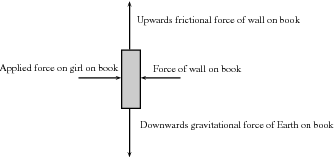| << Chapter < Page | Chapter >> Page > |
Newton's Third Law of Motion deals with the interaction between pairs of objects. For example, if you hold a book up against a wall you are exerting a force on the book (to keep it there) and the book is exerting a force back at you (to keep you from falling through the book). This may sound strange, but if the book was not pushing back at you, your hand would push through the book! These two forces (the force of the hand on the book (F ) and the force of the book on the hand (F )) are called an action-reaction pair of forces. They have the same magnitude, but act in opposite directions and act on different objects (the one force is onto the book and the other is onto your hand).
There is another action-reaction pair of forces present in this situation. The book is pushing against the wall (action force) and the wall is pushing back at the book (reaction). The force of the book on the wall (F ) and the force of the wall on the book (F ) are shown in the diagram.

If body A exerts a force on body B, then body B exerts a force of equal magnitude on body A, but in the opposite direction.
Khan academy video on newtons laws - 3
Newton's action-reaction pairs can be found everywhere in life where two objects interact with one another. The following worked examples will illustrate this:
Dineo is seated in the passenger seat of a car with the seat belt on. The car suddenly stops and he moves forwards until the seat belt stops him. Draw a labeled force diagram identifying two action-reaction pairs in this situation.

Start by drawing the picture. You will be using arrows to indicate the forces so make your picture large enough so that detailed labels can also be added. The picture needs to be accurate, but not artistic! Use stickmen if you have to.
Take one pair at a time and label them carefully. If there is not enough space on the drawing, then use a key on the side.

Tammy travels from the ground floor to the fifth floor of a hotel in a lift. Which ONE of the following statements is TRUE about the force exerted by the floor of the lift on Tammy's feet?
This is a Newton's Third Law question and not Newton II. We need to focus on the action-reaction pairs of forces and not the motion of the lift. The following diagram will show the action-reaction pairs that are present when a person is standing on a scale in a lift.

In this question statements are made about the force of the floor (lift) on Tammy's feet. This force corresponds to F in our diagram. The reaction force that pairs up with this one is F , which is the force that Tammy's feet exerts on the floor of the lift. The magnitude of these two forces are the same, but they act in opposite directions.
It is important to analyse the question first, before looking at the answers as the answers might confuse you. Make sure that you understand the situation and know what is asked before you look at the options.
The correct answer is B.
Tumi presses a book against a vertical wall as shown in the sketch.

A force diagram will look like this:

Note that we had to draw all the forces acting on the book and not the action-reaction pairs. None of the forces drawn are action-reaction pairs, because they all act on the same object (the book). When you label forces, be as specific as possible, including the direction of the force and both objects involved, for example, do not say gravity (which is an incomplete answer) but rather say 'Downward (direction) gravitational force of the Earth (object) on the book (object)'.
If body A exerts a force onto body B, then body B will exert a force equal in magnitude, but opposite in direction, onto body A.
The question only asks for action-reaction forces in the horizontal plane. Therefore:
Pair 1: Action: Applied force of the girl on the book; Reaction: The force of the book on the girl.
Pair 2: Action: Force of the book on the wall; Reaction: Force of the wall on the book.
Note that a Newton III pair will always involve the same combination of words, like 'book on wall' and 'wall on book'. The objects are 'swapped around' in naming the pairs.
Aim:
In this experiment for the entire class, you will use a balloon rocket to investigate Newton's Third Law. A fishing line will be used as a track and a plastic straw taped to the balloon will help attach the balloon to the track.
Apparatus:
You will need the following items for this experiment:
Method:
| Distance (m) | Time (s) | Speed (m s ) | |
| Trial 1 | |||
| Trial 2 | |||
| Trial 3 | |||
| Average: |
While doing the experiment, you should think about,




Notification Switch
Would you like to follow the 'Siyavula textbooks: grade 11 physical science' conversation and receive update notifications?